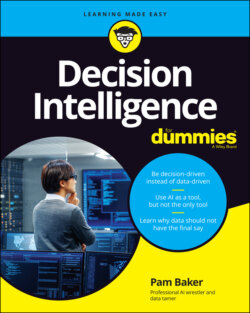Читать книгу Decision Intelligence For Dummies - Pamela Baker - Страница 43
Going where humans fear to tread on data
ОглавлениеThough the processes used under the big umbrella known as decision intelligence vary from one entity to the next, they’re likely to be more warmly embraced by people who were previously concerned that data analytics, and particularly those associated with AI, would eliminate their jobs.
AI, more often than traditional automation, is perceived by some as a direct competitor by managers and executives by virtue of science fiction depictions where AI is smarter than humans and capable of doing even high level jobs. That’s also partly because of the frequent and often wrong assumption that automation is limited to replacing jobs on the lower rungs of the career ladder. By comparison, AI cuts directly from the top. That point was first driven home when Deep Knowledge Ventures, a Hong Kong-based venture capitalist fund, added an algorithm named VITAL as a member of the board of directors in 2017. After that, it appeared that no job was safe from a machine takeover.
OK, some did note that appointing an algorithm to the board was likely a publicity stunt, since most board of directors use data to inform their votes, but the scare that AI may replace business leaders nevertheless lingers.
Deep Knowledge Ventures credits its algorithm with saving the company from bankruptcy caused by “overinvesting in overhyped projects.” Known as Vital (short for Validating Investment Tool for Advancing Life Science), the algorithm established itself as a seemingly crucial member of the board. It’s interesting that the rest of the board — or perhaps it was the stockholders? — apparently had little regard for the directors’ ability to keep the company financially strong.
Executives, whether at the head of business lines or at the top of the company pinnacle, typically fear data fueled algorithms. On the one hand, they’re expected to toe the data-driven company line. On the other hand, data-driven decisions may make their own talents obsolete.
In doesn’t help that executive pay, benefits, and perks are large line items in the biggest of company expenses: payroll costs. You can easily see where the same cost cutting logic that executives use every day could eliminate them as well.
Decision intelligence rebalances the scale by adding more weight to human roles in making key business decisions. That alone makes the concept welcome to leadership. However, decision intelligence is not a license nor the means to return to gut instinct, seat-of-the-pants, ego-driven, or agenda-loaded decision manipulations. The value in decision intelligence is that it is a far more effective way to make business decisions and savvy leaders will instantly grasp its importance to their organizations and careers.
In short, it is a rebalancing of how data is used and viewed. The evolution is in step with maturation patterns in other disciplines and a payback of sorts for data science’s contributions to those developments. One example speaks for many: computing and data science spurred the emergence of Digital Humanities as a new field in the 1950s and has enabled its steady improvement ever since. Now a similar development process is flowing in the other direction.
Decision intelligence is a recipe wherein data, automation, AI and human decision-making capabilities are blended to bake better outcomes into the processes. Further, it is a renewed focus beyond mechanical and digital efficiencies to make the outcomes more meaningful in human applications and impacts.
For many experts and observers, including many executives who have always highly valued business acumen in themselves and other people, decision intelligence’s acknowledgment and inclusion of the same is a natural progression in business applications.
It is a result of the formal recognition of another truth too: no matter how far AI/ML has advanced, combining it with in-house business knowledge always makes for better business outcomes.
